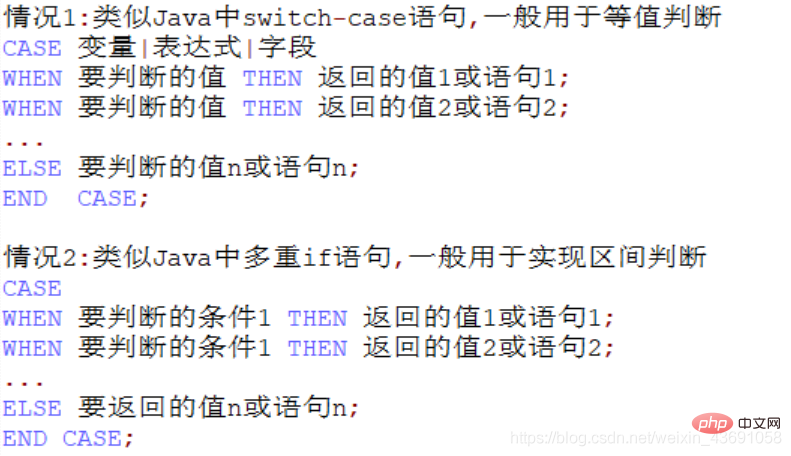MySQL Lecture 6: Process Control

Free learning recommendation: mysql video tutorial
##Article directory
- Branch structure
- IF function
- case structure
- IF structure
Loop structure
The process control in mysql is similar to that in other programming languages, and is also divided into three types:
Sequential structure, Branch structure, Loop structure. Basically, the sequential structures used in the previous articles (except the IF function) are mainly introduced below. The branch structures and loop structures are mainly introduced below.
Branch structure
IF function
Syntax:IF(expression 1, expression 2, expression Formula 3) Description: If expression 1 is true, execute expression 2, otherwise execute expression 3

Features:
- # is used as an expression, nested in other statements, and used in BEGIN- It can be used in END and
BEGIN-END. Use - as an independent statement and can only be placed in BEGIN-END.
If ELSE is omitted and all WHEN are not satisfied, null will be returned. 【演示case作为独立的语句】# 创建存储过程,根据传入的成绩,显示等级:90-100显示A 、 80-90显示B、60-80显示C、否则显示DCREATE PROCEDURE test_case(IN score INT)BEGIN CASE WHEN score>=90 AND score=80 THEN SELECT 'B'; WHEN score>=60 THEN SELECT 'C'; ELSE SELECT 'D'; END CASE;END $CALL test_case(95)$
Copy after login
Syntax:
if condition 1 then statement 1;elseif condition 2 then statement 2;...[else statement n;]end if; <div class="code" style="position:relative; padding:0px; margin:0px;"><pre class="brush:php;toolbar:false">【演示IF结构】# 根据传入的成绩,显示等级:90-100显示A 、 80-90显示B、60-80显示C、否则显示DCREATE FUNCTION test_if(score INT) RETURNS CHARBEGIN
IF score>=90 AND score=80 THEN RETURN 'B';
ELSEIF score>=60 THEN RETURN 'C';
ELSE RETURN 'D';
END IF;END $SELECT test_if(61)$</pre><div class="contentsignin">Copy after login</div></div>Loop structure
There are three types of loop structures in mysql:
| Grammar | Features | |
|---|---|---|
Judge first Then execute 
|
||
Execute first and then judge
|
||
Unconditional infinite loop
|
leave (similar to break in Java)
【演示简单的循环结构】# 案例:批量插入,根据次数插入到admin表中多条记录.CREATE PROCEDURE pro_while1(IN insertCount INT)BEGIN DECLARE i INT DEFAULT 1; WHILE i20则停止TRUNCATE TABLE admin$DROP PROCEDURE test_while1$CREATE PROCEDURE test_while1(IN insertCount INT)BEGIN DECLARE i INT DEFAULT 1; a:WHILE i=20 THEN LEAVE a; END IF; SET i=i+1; END WHILE a;END $CALL test_while1(100)$--------------------------------------------------------------------------------------------【演示添加了iterate的语句】# 案例:批量插入,根据次数插入到admin表中,直插入偶数次CREATE PROCEDURE test_while2(IN insertCount INT)BEGIN DECLARE i INT DEFAULT 0; a:WHILE i<code></code> After learning the process control of mysql, try to complete the following exercises<blockquote> <p><br></p> <pre class="brush:php;toolbar:false">【习题答案】DROP TABLE IF EXISTS stringcontent;CREATE TABLE stringcontent( id INT PRIMARY KEY AUTO_INCREMENT, content VARCHAR(20) );DELIMITER $CREATE PROCEDURE test_pro1(IN insertCount INT)BEGIN DECLARE i INT DEFAULT 1;#定义一个循环变量i,表示插入次数 DECLARE str VARCHAR(26) DEFAULT 'abcdefghijklmnopqrstuvwxyz'; DECLARE strIndex INT DEFAULT 1;#代表起始索引 DECLARE len INT DEFAULT 1;#代表截取的字符的长度 WHILE i<img src="/static/imghw/default1.png" data-src="https://img.php.cn/upload/article/000/000/052/824caf6adae3f27ef5f57d1863fc12a6-4.png" class="lazy" alt="MySQL Lecture 6: Process Control">
mysql tutorial(Video)
The above is the detailed content of MySQL Lecture 6: Process Control. For more information, please follow other related articles on the PHP Chinese website!

Hot AI Tools

Undresser.AI Undress
AI-powered app for creating realistic nude photos

AI Clothes Remover
Online AI tool for removing clothes from photos.

Undress AI Tool
Undress images for free

Clothoff.io
AI clothes remover

AI Hentai Generator
Generate AI Hentai for free.

Hot Article

Hot Tools

Notepad++7.3.1
Easy-to-use and free code editor

SublimeText3 Chinese version
Chinese version, very easy to use

Zend Studio 13.0.1
Powerful PHP integrated development environment

Dreamweaver CS6
Visual web development tools

SublimeText3 Mac version
God-level code editing software (SublimeText3)

Hot Topics
 1385
1385
 52
52
 MySQL: Simple Concepts for Easy Learning
Apr 10, 2025 am 09:29 AM
MySQL: Simple Concepts for Easy Learning
Apr 10, 2025 am 09:29 AM
MySQL is an open source relational database management system. 1) Create database and tables: Use the CREATEDATABASE and CREATETABLE commands. 2) Basic operations: INSERT, UPDATE, DELETE and SELECT. 3) Advanced operations: JOIN, subquery and transaction processing. 4) Debugging skills: Check syntax, data type and permissions. 5) Optimization suggestions: Use indexes, avoid SELECT* and use transactions.
 How to open phpmyadmin
Apr 10, 2025 pm 10:51 PM
How to open phpmyadmin
Apr 10, 2025 pm 10:51 PM
You can open phpMyAdmin through the following steps: 1. Log in to the website control panel; 2. Find and click the phpMyAdmin icon; 3. Enter MySQL credentials; 4. Click "Login".
 MySQL: An Introduction to the World's Most Popular Database
Apr 12, 2025 am 12:18 AM
MySQL: An Introduction to the World's Most Popular Database
Apr 12, 2025 am 12:18 AM
MySQL is an open source relational database management system, mainly used to store and retrieve data quickly and reliably. Its working principle includes client requests, query resolution, execution of queries and return results. Examples of usage include creating tables, inserting and querying data, and advanced features such as JOIN operations. Common errors involve SQL syntax, data types, and permissions, and optimization suggestions include the use of indexes, optimized queries, and partitioning of tables.
 Why Use MySQL? Benefits and Advantages
Apr 12, 2025 am 12:17 AM
Why Use MySQL? Benefits and Advantages
Apr 12, 2025 am 12:17 AM
MySQL is chosen for its performance, reliability, ease of use, and community support. 1.MySQL provides efficient data storage and retrieval functions, supporting multiple data types and advanced query operations. 2. Adopt client-server architecture and multiple storage engines to support transaction and query optimization. 3. Easy to use, supports a variety of operating systems and programming languages. 4. Have strong community support and provide rich resources and solutions.
 How to use single threaded redis
Apr 10, 2025 pm 07:12 PM
How to use single threaded redis
Apr 10, 2025 pm 07:12 PM
Redis uses a single threaded architecture to provide high performance, simplicity, and consistency. It utilizes I/O multiplexing, event loops, non-blocking I/O, and shared memory to improve concurrency, but with limitations of concurrency limitations, single point of failure, and unsuitable for write-intensive workloads.
 MySQL and SQL: Essential Skills for Developers
Apr 10, 2025 am 09:30 AM
MySQL and SQL: Essential Skills for Developers
Apr 10, 2025 am 09:30 AM
MySQL and SQL are essential skills for developers. 1.MySQL is an open source relational database management system, and SQL is the standard language used to manage and operate databases. 2.MySQL supports multiple storage engines through efficient data storage and retrieval functions, and SQL completes complex data operations through simple statements. 3. Examples of usage include basic queries and advanced queries, such as filtering and sorting by condition. 4. Common errors include syntax errors and performance issues, which can be optimized by checking SQL statements and using EXPLAIN commands. 5. Performance optimization techniques include using indexes, avoiding full table scanning, optimizing JOIN operations and improving code readability.
 MySQL's Place: Databases and Programming
Apr 13, 2025 am 12:18 AM
MySQL's Place: Databases and Programming
Apr 13, 2025 am 12:18 AM
MySQL's position in databases and programming is very important. It is an open source relational database management system that is widely used in various application scenarios. 1) MySQL provides efficient data storage, organization and retrieval functions, supporting Web, mobile and enterprise-level systems. 2) It uses a client-server architecture, supports multiple storage engines and index optimization. 3) Basic usages include creating tables and inserting data, and advanced usages involve multi-table JOINs and complex queries. 4) Frequently asked questions such as SQL syntax errors and performance issues can be debugged through the EXPLAIN command and slow query log. 5) Performance optimization methods include rational use of indexes, optimized query and use of caches. Best practices include using transactions and PreparedStatemen
 How to build a SQL database
Apr 09, 2025 pm 04:24 PM
How to build a SQL database
Apr 09, 2025 pm 04:24 PM
Building an SQL database involves 10 steps: selecting DBMS; installing DBMS; creating a database; creating a table; inserting data; retrieving data; updating data; deleting data; managing users; backing up the database.




